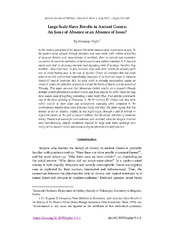Приказ основних података о документу
Large Scale Slave Revolts in Ancient Greece: An Issue of Absence or an Absence of Issue?
| dc.creator | Vujčić, Nemanja | |
| dc.date.accessioned | 2023-11-11T20:59:04Z | |
| dc.date.available | 2023-11-11T20:59:04Z | |
| dc.date.issued | 2023 | |
| dc.identifier.issn | 2407-9677 | |
| dc.identifier.uri | http://reff.f.bg.ac.rs/handle/123456789/5230 | |
| dc.description.abstract | In the modern perception of the Ancient World the massive slave revolts loom largely. To the modern mind, infused, through education and mass media, with notions of sanctity of personal freedom and shamefulness of servitude, there is natural and immediate connection between the institution of slavery and armed, violent resistance to it. Ancient slaves were kept in obviously shameful and degrading state of bondage, therefore they revolted – they must have. In fact, however, large scale slave revolts are actually quite rare in world history and, in the case of Ancient Greece, all examples that one could point to are late and (at least superficially) marginal. If we limit our scope to Classical Greece (5th and 4th centuries BC), the slave revolt is virtually non-existent, unless we choose to widen the definition of slaves to include the helots of Sparta and the penests of Thessaly. This paper assumes that Messenian (helot) revolts are a separate (though perhaps related) phenomenon to slave revolts, and focus only on the latter. There are only three known cases of anything resembling a slave revolt (four, if we add the problematic case of the slave uprising of Drimacus, in the 3nd century BC Chios), and they seem rather minute in their scope and achievement, especially when compared to the contemporary massive slave wars of Roman Sicily and Italy. The paper argues that this absence is not an illusion, created, as one might argue, through a lack of interest or organized silence on the part of ancient authors, but the actual reflection of historical reality. Prospects of success for such endeavor were minimal, while the dangers involved were overwhelming. Specific conditions required for large scale slave uprisings were rarely met in Ancient Greece and consequently the phenomenon itself was rare. | sr |
| dc.language.iso | en | sr |
| dc.publisher | Athens Institute for Education and Research (ATINER) | sr |
| dc.rights | openAccess | sr |
| dc.rights.uri | https://creativecommons.org/licenses/by/4.0/ | |
| dc.source | Athens Journal of History | sr |
| dc.subject | slave revolts | sr |
| dc.subject | slaves | sr |
| dc.subject | Ancient Greece | sr |
| dc.subject | Athens | sr |
| dc.subject | Laurium mines | sr |
| dc.subject | Delos | sr |
| dc.subject | Chios | sr |
| dc.title | Large Scale Slave Revolts in Ancient Greece: An Issue of Absence or an Absence of Issue? | sr |
| dc.type | article | sr |
| dc.rights.license | BY | sr |
| dc.citation.epage | 247 | |
| dc.citation.issue | 3 | |
| dc.citation.spage | 225 | |
| dc.citation.volume | 9 | |
| dc.identifier.doi | 10.30958/ajhis | |
| dc.identifier.fulltext | http://reff.f.bg.ac.rs/bitstream/id/12807/bitstream_12807.pdf | |
| dc.type.version | publishedVersion | sr |

